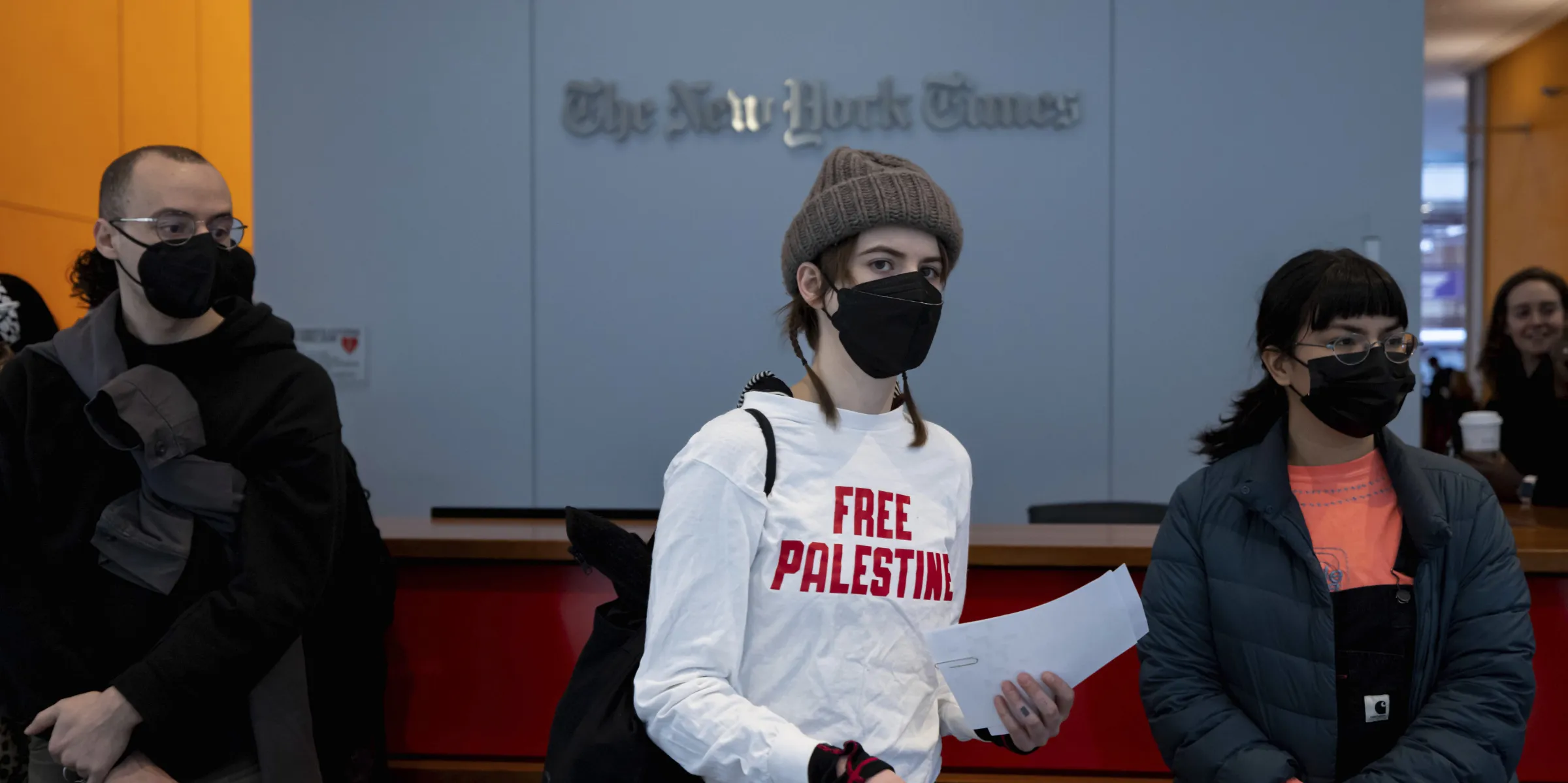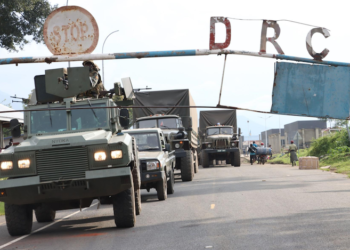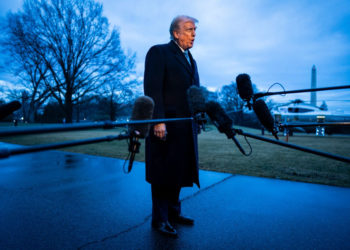Amid the internal battle over the New York Times’s coverage of Israel’s war, top editors handed down a set of directives.
THE NEW YORK TIMES instructed journalists covering Israel’s war on the Gaza Strip to restrict the use of the terms “genocide” and “ethnic cleansing” and to “avoid” using the phrase “occupied territory” when describing Palestinian land, according to a copy of an internal memo obtained
The memo also instructs reporters not to use the word Palestine “except in very rare cases” and to steer clear of the term “refugee camps” to describe areas of Gaza historically settled by displaced Palestinians expelled from other parts of Palestine during previous Israeli–Arab wars. The areas are recognized by the United Nations as refugee camps and house hundreds of thousands of registered refugees.
The memo — written by Times standards editor Susan Wessling, international editor Philip Pan, and their deputies — “offers guidance about some terms and other issues we have grappled with since the start of the conflict in October.”
While the document is presented as an outline for maintaining objective journalistic principles in reporting on the Gaza war, several Times staffers told The Intercept that some of its contents show evidence of the paper’s deference to Israeli narratives.
“It’s the kind of thing that looks professional and logical if you have no knowledge of the historical context of the Palestinian-Israeli conflict.”
“I think it’s the kind of thing that looks professional and logical if you have no knowledge of the historical context of the Palestinian-Israeli conflict,” said a Times newsroom source, who requested anonymity for fear of reprisal, of the Gaza memo. “But if you do know, it will be clear how apologetic it is to Israel.”
First distributed to Times journalists in November, the guidance — which collected and expanded on past style directives about the Israeli–Palestinian conflict — has been regularly updated over the ensuing months. It presents an internal window into the thinking of Times international editors as they have faced upheaval within the newsroom surrounding the paper’s Gaza war coverage.U.S., Not Israel, Shot Down Most Iran Drones and Missiles
Ken Klippenstein, Daniel Boguslaw
Leaked NYT Gaza Memo Tells Journalists to Avoid Words “Genocide,” “Ethnic Cleansing,” and “Occupied Territory”
Jeremy Scahill, Ryan Grim
Leaked Cables Show White House Opposes Palestinian Statehood
Ken Klippenstein, Daniel Boguslaw
“Issuing guidance like this to ensure accuracy, consistency and nuance in how we cover the news is standard practice,” said Charlie Stadtlander, a Times spokesperson. “Across all our reporting, including complex events like this, we take care to ensure our language choices are sensitive, current and clear to our audiences.”
Issues over style guidance have been among a bevy of internal rifts at the Times over its Gaza coverage. In January, The Intercept reported on disputes in the Times newsroom over issues with an investigative story on systematic sexual violence on October 7. The leak gave rise to a highly unusual internal probe. The company faced harsh criticism for allegedly targeting Times workers of Middle East and North African descent, which Times brass denied. On Monday, executive editor Joe Kahn told staff that the leak investigation had been concluded unsuccessfully.
WhatsApp Debates
Almost immediately after the October 7 attacks and the launch of Israel’s scorched-earth war against Gaza, tensions began to boil within the newsroom over the Times coverage. Some staffers said they believed the paper was going out of its way to defer to Israel’s narrative on the events and was not applying even standards in its coverage. Arguments began fomenting on internal Slack and other chat groups.
The debates between reporters on the Jerusalem bureau-led WhatsApp group, which at one point included 90 reporters and editors, became so intense that Pan, the international editor, interceded.
“We need to do a better job communicating with each other as we report the news, so our discussions are more productive and our disagreements less distracting,” Pan wrote in a November 28 WhatsApp message viewed by The Intercept and first reported by the Wall Street Journal. “At its best, this channel has been a quick, transparent and productive space to collaborate on a complex, fast-moving story. At its worst, it’s a tense forum where the questions and comments can feel accusatory and personal.”
Pan bluntly stated: “Do not use this channel for raising concerns about coverage.”
Among the topics of debate in the Jerusalem bureau WhatsApp group and exchanges on Slack, reviewed by The Intercept and verified with multiple newsroom sources, were Israeli attacks on Al-Shifa Hospital, statistics on Palestinian civilian deaths, the allegations of genocidal conduct by Israel, and President Joe Biden’s pattern of promoting unverified allegations from the Israeli government as fact. (Pan did not respond to a request for comment.)
“It’s not unusual for news companies to set style guidelines. But there are unique standards applied to violence perpetrated by Israel.”
Many of the same debates were addressed in the Times’s Gaza-specific style guidance and have been the subject of intense public scrutiny.
“It’s not unusual for news companies to set style guidelines,” said another Times newsroom source, who also asked for anonymity. “But there are unique standards applied to violence perpetrated by Israel. Readers have noticed and I understand their frustration.”
“Words Like ‘Slaughter’”
The Times memo outlines guidance on a range of phrases and terms. “The nature of the conflict has led to inflammatory language and incendiary accusations on all sides. We should be very cautious about using such language, even in quotations. Our goal is to provide clear, accurate information, and heated language can often obscure rather than clarify the fact,” the memo says.
“Words like ‘slaughter,’ ‘massacre’ and ‘carnage’ often convey more emotion than information. Think hard before using them in our own voice,” according to the memo. “Can we articulate why we are applying those words to one particular situation and not another? As always, we should focus on clarity and precision — describe what happened rather than using a label.”
DEIR AL-BALAH, GAZA – NOVEMBER 7: Civil defense teams and citizens continue search and rescue operations after an airstrike hits the building belonging to the Maslah family during the 32nd day of Israeli attacks in Deir Al-Balah, Gaza on November 7, 2023. (Photo by Ashraf Amra/Anadolu via Getty Images)
Read Our Complete Coverage
Israel’s War on Gaza
Despite the memo’s framing as an effort to not employ incendiary language to describe killings “on all sides,” in the Times reporting on the Gaza war, such language has been used repeatedly to describe attacks against Israelis by Palestinians and almost never in the case of Israel’s large-scale killing of Palestinians.
In January, The Intercept published an analysis of New York Times, Washington Post, and Los Angeles Times coverage of the war from October 7 through November 24 — a period mostly before the new Times guidance was issued. The Intercept analysis showed that the major newspapers reserved terms like “slaughter,” “massacre,” and “horrific” almost exclusively for Israeli civilians killed by Palestinians, rather than for Palestinian civilians killed in Israeli attacks.
Related
Coverage of Gaza War in the New York Times and Other Major Newspapers Heavily Favored Israel, Analysis Shows
The analysis found that, as of November 24, the New York Times had described Israeli deaths as a “massacre” on 53 occasions and those of Palestinians just once. The ratio for the use of “slaughter” was 22 to 1, even as the documented number of Palestinians killed climbed to around 15,000.
The latest Palestinian death toll estimate stands at more than 33,000, including at least 15,000 children — likely undercounts due to Gaza’s collapsed health infrastructure and missing persons, many of whom are believed to have died in the rubble left by Israel’s attacks over the past six months.
Touchy Debates
The Times memo touches on some of the most highly charged — and disputed — language around the Israeli–Palestinian conflict. The guidance spells out, for instance, usage of the word “terrorist,” which The Intercept previously reported was at the center of a spirited newsroom debate.
“It is accurate to use ‘terrorism’ and ‘terrorist’ in describing the attacks of Oct. 7, which included the deliberate targeting of civilians in killings and kidnappings,” according to the leaked Times memo. “We should not shy away from that description of the events or the attackers, particularly when we provide context and explanation.”
The guidance also instructs journalists to “Avoid ‘fighters’ when referring to the Oct. 7 attack; the term suggests a conventional war rather than a deliberate attack on civilians. And be cautious in using ‘militants,’ which is interpreted in different ways and may be confusing to readers.”
In the memo, the editors tell Times journalists: “We do not need to assign a single label or to refer to the Oct. 7 assault as a ‘terrorist attack’ in every reference; the word is best used when specifically describing attacks on civilians. We should exercise restraint and can vary the language with other accurate terms and descriptions: an attack, an assault, an incursion, the deadliest attack on Israel in decades, etc. Similarly, in addition to ‘terrorists,’ we can vary the terms used to describe the Hamas members who carried out the assault: attackers, assailants, gunmen.”
Related
The Story Behind the New York Times October 7 Exposé
The Times does not characterize Israel’s repeated attacks on Palestinian civilians as “terrorism,” even when civilians have been targeted. This is also true of Israel’s assaults on protected civilian sites, including hospitals.
In a section with the headline “‘Genocide’ and Other Incendiary Language,” the guidance says, “‘Genocide’ has a specific definition in international law. In our own voice, we should generally use it only in the context of those legal parameters. We should also set a high bar for allowing others to use it as an accusation, whether in quotations or not, unless they are making a substantive argument based on the legal definition.”
Regarding “ethnic cleansing,” the document calls it “another historically charged term,” instructing reporters: “If someone is making such an accusation, we should press for specifics or supply proper context.”
Bucking International Norms
In the cases of describing “occupied territory” and the status of refugees in Gaza, the Times style guidelines run counter to norms established by the United Nations and international humanitarian law.
On the term “Palestine” — a widely used name for both the territory and the U.N.-recognized state — the Times memo contains blunt instructions: “Do not use in datelines, routine text or headlines, except in very rare cases such as when the United Nations General Assembly elevated Palestine to a nonmember observer state, or references to historic Palestine.” The Times guidance resembles that of the Associated Press Stylebook.
The memo directs journalists not to use the phrase “refugee camps” to describe long-standing refugee settlements in Gaza. “While termed refugee camps, the refugee centers in Gaza are developed and densely populated neighborhoods dating to the 1948 war. Refer to them as neighborhoods, or areas, and if further context is necessary, explain how they have historically been called refugee camps.”
The United Nations recognizes eight refugee camps in the Gaza Strip. As of last year, before the war started, the areas were home to more than 600,000 registered refugees. Many are descendants of those who fled to Gaza after being forcibly expelled from their homes in the 1948 Arab–Israeli War, which marked the founding of the Jewish state and mass dispossession of hundreds of thousands of Palestinians.
The Israeli government has long been hostile to the historical fact that Palestinians maintain refugee status, because it signifies that they were displaced from lands they have a right to return to.
“It’s like, ‘Oh let’s not say occupation because it might make it look like we’re justifying a terrorist attack.’”
Since October 7, Israel has repeatedly bombed refugee camps in Gaza, including Jabaliya, Al Shati, Al Maghazi, and Nuseirat.
The memo’s instructions on the use of “occupied territories” says, “When possible, avoid the term and be specific (e.g. Gaza, the West Bank, etc.) as each has a slightly different status.” The United Nations, along with much of the world, considers Gaza, the West Bank, and East Jerusalem to be occupied Palestinian territories, seized by Israel in the 1967 Arab–Israeli war.
The admonition against the use of the term “occupied territories,” said a Times staffer, obscures the reality of the conflict, feeding into the U.S. and Israeli insistence that the conflict began on October 7.
“You are basically taking the occupation out of the coverage, which is the actual core of the conflict,” said the newsroom source. “It’s like, ‘Oh let’s not say occupation because it might make it look like we’re justifying a terrorist attack.’”







Discussion about this post